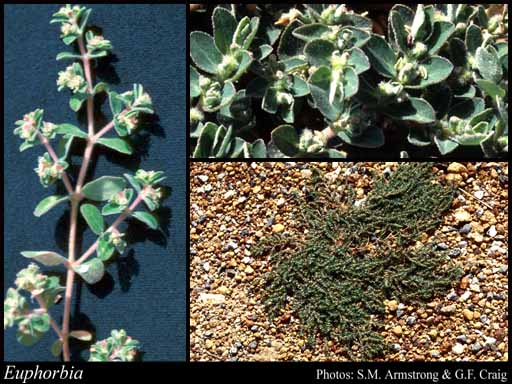- Reference
- Sp.Pl. [Linnaeus] 2:450 (1753)
- Name Status
- Current

Scientific Description
Family Euphorbiaceae.
Habit and leaf form. Trees, or shrubs, or herbs; evergreen, or deciduous; laticiferous (latex bitter, corrosive). ‘Normal’ plants, or switch-plants; ‘cactoid’. Plants succulent, or non-succulent. Herbs annual to perennial. Mesophytic, or xerophytic. Leaves minute to large; alternate, or opposite, or whorled; spiral, or distichous; ‘herbaceous’, or leathery, or fleshy; petiolate (usually), or subsessile to sessile; non-sheathing; gland-dotted, or not gland-dotted; simple. Leaf blades entire, or dissected (lobed); pinnately veined, or palmately veined. Leaves with stipules, or without stipules. Stipules conspicuous or minute; caducous, or persistent. Leaves without a persistent basal meristem. Leaf anatomy. Urticating hairs present, or absent. Stem anatomy. Nodes tri-lacunar, or unilacunar. Secondary thickening developing from a conventional cambial ring, or anomalous; from a single cambial ring.
Reproductive type, pollination. Fertile flowers functionally male, or functionally female. Unisexual flowers present. Plants monoecious. Female flowers solitary. Male flowers aggregated in ‘inflorescences’ (several male flowers surround the female flower in each head); without pistillodes (the single stamen with a basal bracteole). Entomophilous.
Inflorescence and flower features. Flowers aggregated in ‘inflorescences’; in heads. Inflorescences simple, or compound (then arranged in umbels); terminal, or axillary; the peduncles usually several times dichotomous; with involucral bracts (the cyathium obconic to campanulate, of 5 connate bracts resembling a calyx with 5 membranous teeth usually alternating with 4 or 5 broad glands, the glands sometimes with petal-like appendages along their outer margin); pseudanthial. Flowers regular. Hypogynous disk absent. Perianth absent. Fertile stamens present, or absent (female flowers). Androecium 1. Androecium exclusively of fertile stamens. Stamens 1; erect in bud, or inflexed in bud. Filaments articulate. Anthers dehiscing via short slits (the cells globular); extrorse, or introrse; bisporangiate, or tetrasporangiate. Fertile gynoecium present, or absent (male flowers). Gynoecium 3 carpelled. The pistil 3 celled. Gynoecium syncarpous; synovarious, or synstylovarious (depending on interpretation of partially connate styles); superior. Ovary plurilocular; 3 locular. Styles 3; partially joined (shortly connate at the base); forked (shortly 2-lobed to deeply 2-branched); apical; becoming exserted (from the involucre when mature). Stigmas 6; dry type; papillate, or non-papillate; Group II type. Placentation axile, or apical. Ovules 1 per locule; pendulous; epitropous; with ventral raphe, or with dorsal raphe; arillate, or non-arillate; orthotropous, or anatropous, or hemianatropous.
Fruit and seed features. Fruit non-fleshy; a schizocarp (trigonous, pendulous from the involucre). Mericarps 3. Fruit elastically dehiscent (schizocarpic capsules often splitting elastically), or passively dehiscent. Seeds 1 per mericarp. Seeds endospermic. Endosperm oily. Seeds arillate, or non-arillate. Cotyledons 2; flat (large). Embryo straight. Seedling. Germination phanerocotylar, or cryptocotylar.
Physiology, biochemistry. Mustard-oils present, or absent.
Geography, cytology, number of species. Native of Australia. Not endemic to Australia. Australian states and territories: Western Australia, South Australia, Northern Territory, Queensland, New South Wales, Victoria, Australian Capital Territory, and Tasmania. Northern Botanical Province, Eremaean Botanical Province, and South-West Botanical Province.